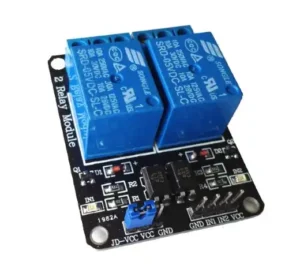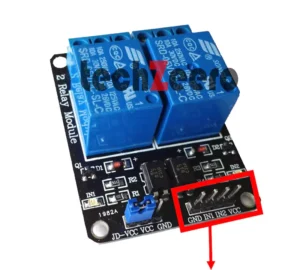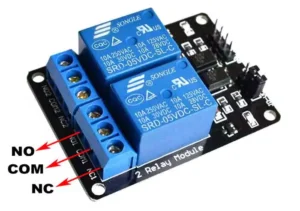Relay is a switch which is operated electrically. Relays are work on the electromagnetic principle to mechanically operate a switch but there are also other relays that operate on other principles such as solid-state relays.
Relays are used to control a circuit by a separate low power signal or, controlled several circuits by one signal.
Relay is an electrically operated switch that can be turned on by a circuit or device or current can be turned on.
The relay can be controlled through Arduino in a very simple way, like controlling an LED.
Related Article: Relay Module with Arduino
A relay module is a hardware PCB board with relay cubes, input-output pins, LEDs and trigger pins which are in a connected circuit.

In the above image, there is a two-channel relay module and the two blue cubes in it are relays. There are other varieties of relay modules with one, four and eight channels.
Pin Connection With Arduino
Typically, a relay module consists of input pins for control signals and output pins for switching devices.
The most common relay modules have three primary pins: NO (Normally Open), NC (Normally Closed), and COM (Common). These pins determine how the switch operates when triggered by an input signal.

- GND:- It connects to the ground pin of Arduino.
- IN1:- It connects to the digital pin of Arduino to control the first relay.
- IN2:- It connects to Arduino digital pin to controls the second relay (if we using the second relay).
- VCC:- connects to 5V of Arduino.
Main Voltage Connections
The relay has 3 possible connections with the main voltage are:

- COM:- This is a common pin.
- NO (Normally Open):- According to the name Normally Open (NO) pin has no direct connection with the Common pin. If we trigger the relay, NO connects with the COM pin and provided power supply. We connect the lamp or the appliance wire with it.
- NC (Normally Closed):- There is a direct connection between the common pin and the normally closed pin, even the relay is off. If we trigger the relay, NC disconnects with COM pin and no supply provided to load.
If you want to control a bulb, then it’s better to connect the bulb +ve wire to a normally-open (NO) pin because we just want to control the bulb.
Applications of Relay Modules
Industries widely utilize relay modules as versatile components in various applications.
- One common application of relay modules is in home automation systems, where they help control lighting, heating, and other household appliances remotely.
- In the automotive industry, relay modules play a crucial role in controlling vehicle electronics such as headlights, windshield wipers, and fuel pumps. They ensure efficient operation and safety while driving.
- Industrial automation relies heavily on relay modules to control machinery and equipment, enabling precise activation or deactivation of processes based on specific conditions. This enhances productivity and ensures smooth operations in manufacturing plants.
- Furthermore, relay modules find applications in security systems for activating alarms or triggering surveillance cameras when certain events occur. Their reliability makes them essential components for maintaining the security of properties.